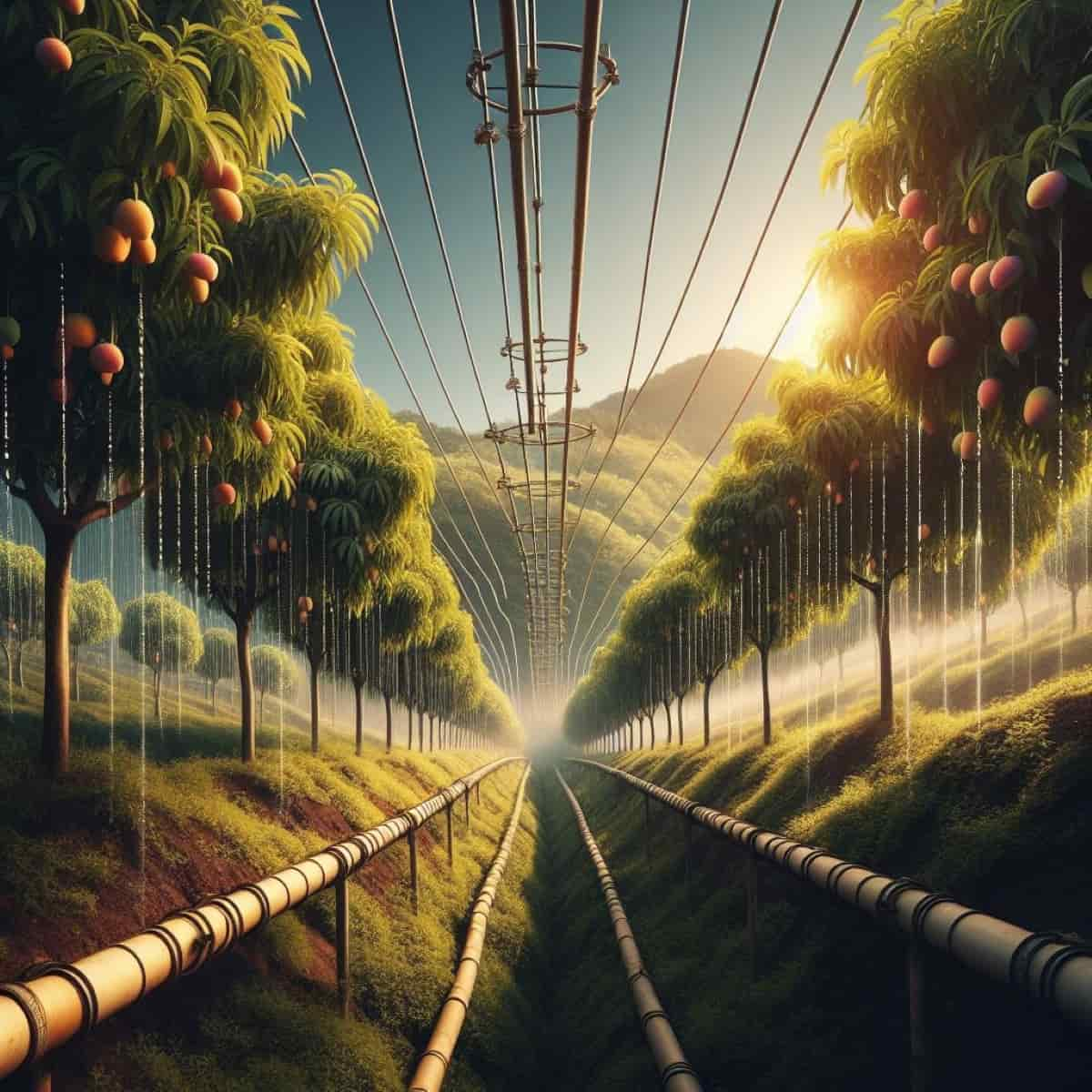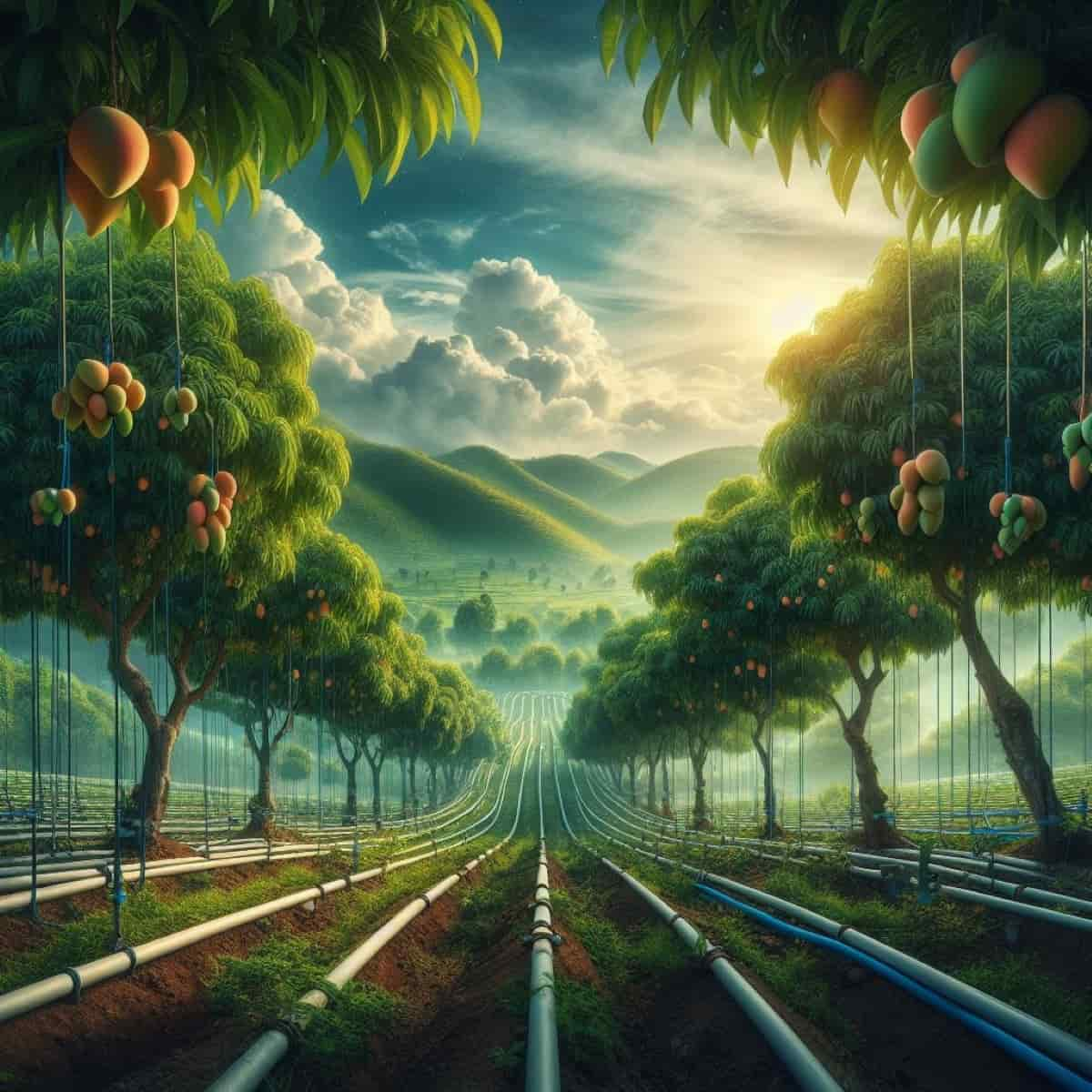Drip irrigation proves to be a judicious investment for mango plantations, enhancing water efficiency and crop yield. The initial investment per acre typically ranges from Rs. 1,00,000 to Rs. 1,50,000, encompassing expenses like drip system components, filters, pumps, and installation. Fortunately, Indian government subsidies can significantly offset these expenses.

Various state and central agricultural departments provide subsidies ranging from 45% to 50%, making the net investment substantially more affordable for farmers. This not only encourages sustainable farming practices but also ensures a quicker return on investment for mango growers adopting drip irrigation.
Cost of Drip Irrigation Per Acre for Mango Plantation
Evaluate the Cost of Drip Lines and Emitters for Mango Fields
The cost of drip lines and emitters for mango fields is a crucial component of the overall investment. Drip lines, responsible for water distribution, typically cost around ₹8,000 to ₹12,000 per acre. Emitters, which regulate water flow to individual plants, contribute an additional ₹5,000 to ₹8,000 per acre. The total cost depends on factors such as the spacing of emitters and the type of drip line selected. Farmers need to choose high-quality materials to ensure durability and efficient water delivery.
Analyze the Expense of Filters and Pressure Regulators in Drip Irrigation Systems
In a drip irrigation system for mango plantations, filters and pressure regulators play a pivotal role in ensuring the efficient and uniform distribution of water to the plants. Filters are essential to prevent clogging of emitters and drip lines by removing impurities from the water. The cost of filters can range from ₹5,000 to ₹10,000 per acre, depending on the type and capacity.
Pressure regulators, responsible for maintaining optimal water pressure throughout the system, contribute to the overall expense. These regulators help prevent damage to emitters and ensure uniform water distribution. The cost of pressure regulators typically falls in the range of ₹4,000 – ₹8,000 per acre.
Estimate the Cost of Automation and Control Systems in Drip Irrigation for Mango
The cost of these systems varies based on the level of automation and the technology employed. On average, the expense can range from ₹15,000 to ₹30,000 per acre. Automation includes the installation of controllers, sensors, and actuators that enable precise scheduling and monitoring of irrigation cycles.
The controllers, which govern the timing and duration of irrigation, typically contribute to the higher end of the cost spectrum. Sensors, such as soil moisture sensors, help assess the actual water needs of the plants and optimize water usage. Actuators regulate valves and flow rates, enhancing control over water distribution.
Assess the Price of Pumps and Pumping Stations for Drip Irrigation in Mango Farming
Pumps are essential for delivering water from the source to the drip system, ensuring consistent and efficient irrigation. The expense for pumps and pumping stations can range from ₹30,000 to ₹60,000 per acre, depending on factors like water source, lift requirements, and pump capacity.
In case you missed it: How to Prevent Mango Fruit Rot Naturally: How to Control with Natural and Organic Treatment

Additionally, the type of pump (submersible or surface) influences the overall cost. Investing in a reliable and energy-efficient pump is crucial for the sustained success of the drip irrigation system, as it directly impacts water distribution and overall system performance in mango farming.
Explore the Cost of Fertilizer and Nutrient Injection Systems in Drip Irrigation for Mango
Integrating fertilizer and nutrient injection systems into drip irrigation for mango cultivation enhances the precision of nutrient delivery, promoting optimal plant growth. The cost of these systems typically ranges from ₹8,000 to ₹15,000 per acre. This includes the expense of injectors, tanks, and monitoring equipment. The investment is justified by the improved efficiency of nutrient application, leading to healthier and more productive mango trees.
Calculate the Labor and Installation Costs for Drip Irrigation in Mango Plantations
The labor and installation costs for drip irrigation in mango plantations typically range from Rs. 20,000 to Rs. 40,000 per acre. Skilled labor is required for tasks such as trenching, laying pipes, installing filters, valves, and emitters, and ensuring proper system calibration. The terrain of the plantation, soil conditions, and the complexity of the system can influence labor costs. In addition to the workforce, the expense includes the cost of materials like pipes, connectors, and fittings. Professional installation is crucial to the system’s efficiency and longevity.
Factor the Maintenance and Repair Expenses for Drip Irrigation Systems in Mango Farming
Maintenance and repair expenses for drip irrigation systems in mango farming typically amount to Rs. 5,000 to Rs. 10,000 per acre annually. Regular maintenance involves checking and cleaning filters, inspecting emitters, and ensuring proper system functioning. Expenses may vary based on various factors like the system’s age, the quality of components, and the frequency of issues.
In case you missed it: How to Grow Nam Dok Mai Mango: A Step-By-Step Guide to the Tasty Thai Yellow Variety

Timely repairs are crucial to prevent water wastage and maintain optimal irrigation. Investing in routine maintenance not only sustains the system’s efficiency but also minimizes the risk of major breakdowns, contributing to long-term savings and the overall success of the mango plantation.
Energy Costs Associated with Drip Irrigation in Mango Cultivation
The energy costs associated with drip irrigation in mango cultivation are relatively modest, typically ranging from Rs. 5,000 to Rs. 10,000 per acre annually. This includes the electricity required to power water pumps and, if applicable, automated control systems. Energy consumption varies based on factors like pump capacity, water source depth, and irrigation frequency.
While drip irrigation is known for its water efficiency, using low-energy-consuming pumps and adopting renewable energy sources can further minimize costs. The relatively low energy expenses make drip irrigation an economically viable and sustainable choice for mango farmers, complementing its water-saving benefits.
Government Subsidy for Mango Drip Irrigation
In many regions, agricultural departments offer substantial financial support to farmers investing in drip irrigation systems. The subsidy coverage typically ranges from 45-50% of the total installation cost. This financial assistance aims to encourage sustainable water management practices, improve crop yield, and reduce water wastage. Farmers can access these subsidies by applying through relevant government schemes, and the disbursement process often involves verification of the installed system’s compliance with specified standards.
Compare the Overall Operational Costs of Drip Irrigation vs. Traditional Methods in Mango Farming
Drip irrigation in mango farming tends to have lower overall operational costs compared to traditional methods. While the initial investment in drip systems may be higher, the efficiency gains result in reduced water consumption, lower labor requirements, and increased crop yields. Traditional methods, relying on flood or furrow irrigation, often incur higher labor and water expenses.
In case you missed it: How to Prune a Mango Tree and When to Prune Mango Trees

Additionally, drip systems are conducive to automation, further optimizing resource use. Despite the initial outlay, the long-term operational savings, along with potential government subsidies, make drip irrigation economically advantageous and environmentally sustainable for mango cultivation.
Conclusion
In conclusion, while the initial expenses may seem significant, the efficiency gains, water savings, and government subsidies make drip irrigation a financially viable and sustainable choice for mango farmers. The long-term benefits not only contribute to increased crop yields but also align with broader agricultural goals of resource conservation and sustainable farming practices.
- Feed Your Flock for Less: Top 10 Tips to Save on Chicken Feed
- Ultimate Guide to Ossabaw Island Hog: Breeding, Raising, Diet, and Care
- Hatching Answers: The Top 10 Reasons Your Chickens Aren’t Laying Eggs
- Eggs and Economics: Breaking Down the Cost of Raising Backyard Chickens
- Defend Your Greens: Proven Methods to Keep Iguanas Out of Your Garden
- Ultimate Guide to Cinnamon Queen Chicken: A Comprehensive Guide for Beginners
- Ultimate Guide to California Tan Chicken: Breeding, Raising, Diet, Egg-Production and Care
- Ultimate Guide to Marsh Daisy Chicken: Breeding, Raising, Diet, and Care
- 10 Types of Chicken Farming Businesses You Can Start for Profits